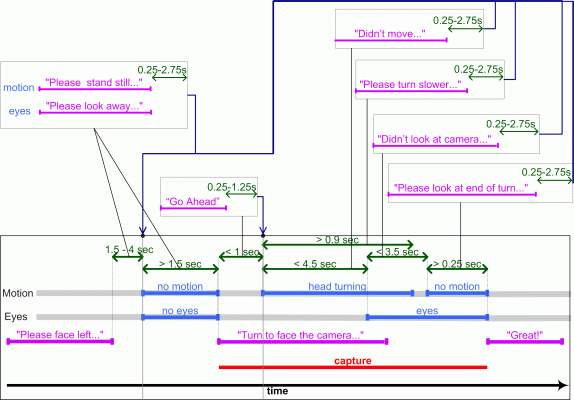| Ana Ramírez Chang and Marc Davis. "Active Capture Design Case Study: SIMS Faces." In Proceedings of Conference on Designing for User eXperience (DUX 2005) in San Francisco, California, 2005. paper video |
|
We present a design case study for the SIMS Faces
application. The SIMS Faces application is an Active
Capture application that works with the user to take
her picture and record her saying her name for
inclusion on the department web page. Active Capture
applications are systems that capture and direct human
action by working with the user, directing her and
monitoring her progress, to complete a common goal,
in this case taking her picture when she is smiling and
looking at the camera. In addition to producing a
working Active Capture application, the project also
included studying the design of Active Capture
applications. The team conducted an ethnographic
study to inform the design of the interaction with
the user, prototyped a set of tools to support the design
process, and iterated a design process involving
bodystorming, a Wizard-of-Oz study, the prototyped
tools, and a user test of the implemented application. |
|
| Ana Ramírez Chang and Marc Davis. "Designing Systems that Direct Human Action." In Proceedings of CHI 2005, Conference on Human Factors in Computing Systems (2005). paper |
|
In this paper we present a user-centered design process for Active Capture systems. These systems bring together techniques from human-human direction practice, multimedia signal processing, and human-computer interaction to form computational systems that automatically analyze and direct human action. The interdependence between the design of multimedia signal parsers and the user interaction script presents a unique challenge in the design process. We have developed an iterative user-centered design process for Active Capture systems that incorporates bodystorming, wizard-of-oz user studies, iterative parser design, and traditional user studies, based on our experience designing a portrait camera system that works with the user to record her name and take her picture. Based on our experiences, we lay out a set of recommendations for future tools to support such a design process. |
| |
|
| Class Project: Multimedia Information (IS246) Spring'03 - Active Capture Visual Language. Paper |
| |
|
